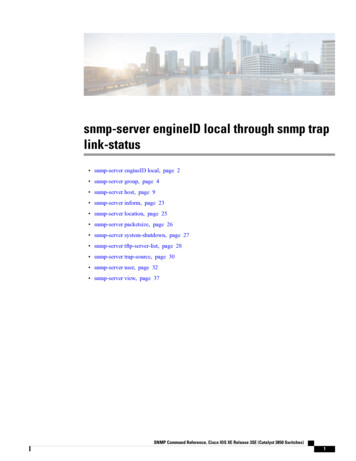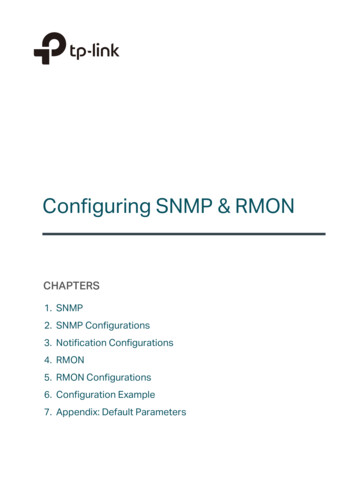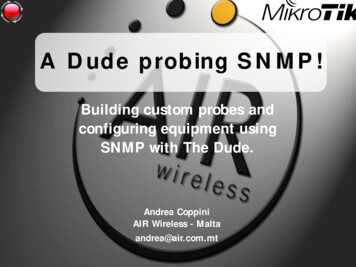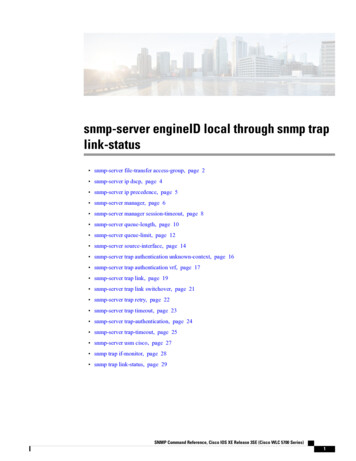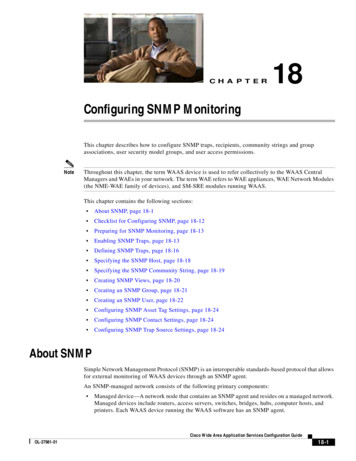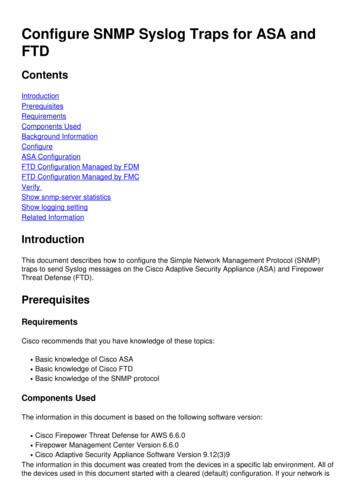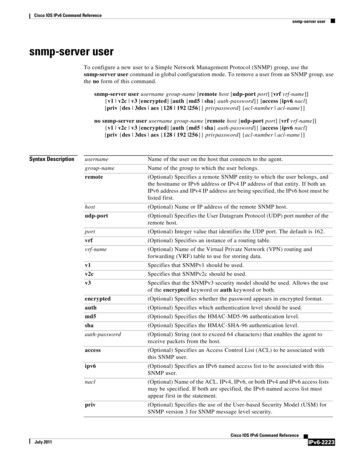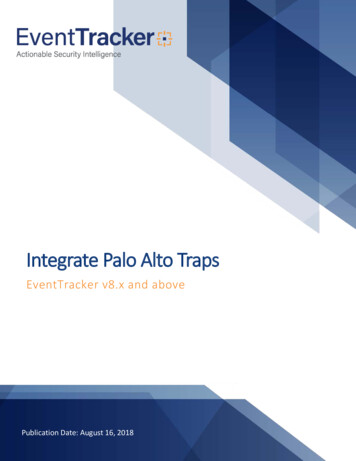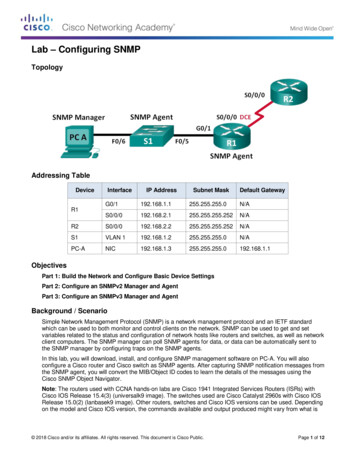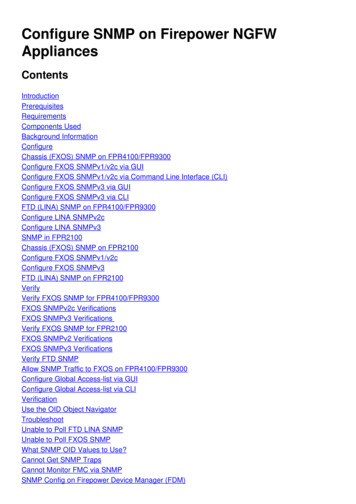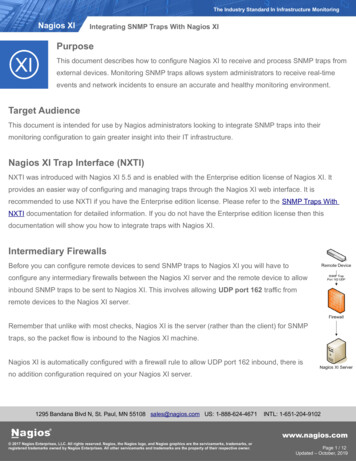
Transcription
The Industry Standard In Infrastructure MonitoringNagios XIIntegrating SNMP Traps With Nagios XIPurposeThis document describes how to configure Nagios XI to receive and process SNMP traps fromexternal devices. Monitoring SNMP traps allows system administrators to receive real-timeevents and network incidents to ensure an accurate and healthy monitoring environment.Target AudienceThis document is intended for use by Nagios administrators looking to integrate SNMP traps into theirmonitoring configuration to gain greater insight into their IT infrastructure.Nagios XI Trap Interface (NXTI)NXTI was introduced with Nagios XI 5.5 and is enabled with the Enterprise edition license of Nagios XI. Itprovides an easier way of configuring and managing traps through the Nagios XI web interface. It isrecommended to use NXTI if you have the Enterprise edition license. Please refer to the SNMP Traps WithNXTI documentation for detailed information. If you do not have the Enterprise edition license then thisdocumentation will show you how to integrate traps with Nagios XI.Intermediary FirewallsBefore you can configure remote devices to send SNMP traps to Nagios XI you will have toconfigure any intermediary firewalls between the Nagios XI server and the remote device to allowinbound SNMP traps to be sent to Nagios XI. This involves allowing UDP port 162 traffic fromremote devices to the Nagios XI server.Remember that unlike with most checks, Nagios XI is the server (rather than the client) for SNMPtraps, so the packet flow is inbound to the Nagios XI machine.Nagios XI is automatically configured with a firewall rule to allow UDP port 162 inbound, there isno addition configuration required on your Nagios XI server.1295 Bandana Blvd N, St. Paul, MN 55108 sales@nagios.com US: 1-888-624-4671INTL: 1-651-204-9102www.nagios.com 2017 Nagios Enterprises, LLC. All rights reserved. Nagios, the Nagios logo, and Nagios graphics are the servicemarks, trademarks, orregistered trademarks owned by Nagios Enterprises. All other servicemarks and trademarks are the property of their respective owner.Page 1 / 12Updated – October, 2019
The Industry Standard In Infrastructure MonitoringNagios XIIntegrating SNMP Traps With Nagios XISNMP Trap Translator (SNMPTT)SNMPTT is what processes the receivedtraps and decides if they should be sentto Nagios XI. This documentation willbriefly explain how SNMPTT works andhow it can be configured.A flowchart diagram will help explain thisvisually:SNMPTT checks incoming traps against existing trap definitions. If the incoming trap matches an incomingdefinition, the trap is passed to Nagios XI, where the trap receives standard Nagios treatment: Event is logged Alert is generated Notifications / Event Handlers (or both) occur. If the incoming trap does not match an incoming definition, the trap is sent to the Unknown Trap Log Unconfigured Objects are handled with the SNMP Trap WizardDefining TrapsTrap definitions can be created in two ways. Created from a MIB you upload to Nagios XI Explained in the Installing MIBs section In a case where either no MIB exists, or the existing MIB does not define a required trap, you can definethe trap in the /etc/snmp/snmptt.conf file This is also how you can define custom/complex trap definitions Explained in the Defining Traps In snmptt.conf section1295 Bandana Blvd N, St. Paul, MN 55108 sales@nagios.com US: 1-888-624-4671INTL: 1-651-204-9102www.nagios.com 2017 Nagios Enterprises, LLC. All rights reserved. Nagios, the Nagios logo, and Nagios graphics are the servicemarks, trademarks, orregistered trademarks owned by Nagios Enterprises. All other servicemarks and trademarks are the property of their respective owner.Page 2 / 12Updated – October, 2019
The Industry Standard In Infrastructure MonitoringNagios XIIntegrating SNMP Traps With Nagios XIInstalling MIBsIf the remote device you are sending traps from has a MIB file, you can upload this MIB file to configuresnmptt on the Nagios XI server to understand these incoming traps. This can be done via Admin SystemExtensions Manage MIBs.Click the Browse button to find the MIB to be added. Check the box Process trap and then click the UploadMIB button.This will find any trap definitions in the MIB file and add them to the /etc/snmp/snmptt.conf file, they willbe added as an EVENT to this file. The MIB will also be copied into the /usr/share/snmp/mibs/ directory.If you had previously uploaded a MIB file but did not select the Process trap check box you can run thefollowing command in a terminal session:addmib PathToNewMIB For example:addmib /usr/share/snmp/mibs/NAGIOS-NOTIFY-MIB.txtDefining Traps In snmptt.confTrap definitions are defined in the /etc/snmp/snmptt.conf file, they always start with EVENT line arefollowed by a FORMAT line and an EXEC line. There are other lines that will exist but are not mandatory. Forexample anything between SDESC and EDESC is purely comment information and is not processed as part ofthe trap.EVENTThis is the line that has the OID / MIB, if this is matched against the incoming trap then SNMPTT will action itby executing the EXEC line.1295 Bandana Blvd N, St. Paul, MN 55108 sales@nagios.com US: 1-888-624-4671INTL: 1-651-204-9102www.nagios.com 2017 Nagios Enterprises, LLC. All rights reserved. Nagios, the Nagios logo, and Nagios graphics are the servicemarks, trademarks, orregistered trademarks owned by Nagios Enterprises. All other servicemarks and trademarks are the property of their respective owner.Page 3 / 12Updated – October, 2019
The Industry Standard In Infrastructure MonitoringNagios XIIntegrating SNMP Traps With Nagios XIFORMATThis allows you to define what is logged in the /var/log/snmptt/snmptt.log file when an EVENT ismatched. If a received trap is NOT matched by SNMPTT then it will be logged in the/var/log/snmptt/snmpttunknown.log file.EXECThis is the line that submits the received trap to Nagios XI. By default it will execute the/usr/local/bin/snmptraphandling.py script which will submit the check result to Nagios XI.Here is an example (the EXEC line is wrapped over two lines):EVENT linkDown .1.3.6.1.6.3.1.1.5.3 "Status Events" CriticalFORMAT Link down on interface 1.Admin state: 2.Operational state: 3EXEC /usr/local/bin/snmptraphandling.py " r" "SNMP Traps" " s" " @" " -*" "Linkdown on interface 1.Admin state: 2.Operational state: 3"Very briefly:The EVENT line will define this trap as CRITICAL when submitted to Nagios XIThe EXEC line will be targeting the service called SNMP Traps when submitted to Nagios XINote: If you find the EXEC line does not look like the examples above, please follow the steps in this KBarticle: Nagios XI - Update Default snmptt.conf EVENT.SNMPTT Processing BehaviorIt's important to note that SNMPTT will compare a received trap against every EVENT in the snmptt.conffile. Multiple EVENTS with the same OID / MIB can exist and hence multiple EXEC statements can beexecuted. The key point being made here is that SNMPTT does not stop looking through the snmptt.conffile once an EVENT is matched.1295 Bandana Blvd N, St. Paul, MN 55108 sales@nagios.com US: 1-888-624-4671INTL: 1-651-204-9102www.nagios.com 2017 Nagios Enterprises, LLC. All rights reserved. Nagios, the Nagios logo, and Nagios graphics are the servicemarks, trademarks, orregistered trademarks owned by Nagios Enterprises. All other servicemarks and trademarks are the property of their respective owner.Page 4 / 12Updated – October, 2019
The Industry Standard In Infrastructure MonitoringNagios XIIntegrating SNMP Traps With Nagios XIThis behavior allows for more complicated EVENTs that have filters applied using MATCH lines. If you have twoidentical EVENTS, it's possible that you'll submit two traps to Nagios XI at the same time and the last trapreceived will overwrite the previous one. This is outside of the scope of this documentation however it is worthmentioning.Send Test SNMP TrapIt's very easy to send a test trap to Nagios XI to demonstrate how traps are received by Nagios XI. In aterminal session execute the following command:snmptrap -v 2c -c public 127.0.0.1 '' linkUp ifDescr s eth0 ifAdminStatus i 1 ifOperStatus i 1Once you execute this command you'll see the following logged in the /var/log/snmptt/snmptt.log file:Mon Nov 28 11:15:42 2016 .1.3.6.1.6.3.1.1.5.4 Normal "Status Events" localhost- Link up on interface eth0.Admin state: up.Operational state: upYou'll also see the following logged in the /usr/local/nagios/var/nagios.log file:[1480298939] Warning:Passive check result was received for service 'SNMPTraps' on host 'localhost', but the service could not be found![1480298939] Error: External command failed - PROCESS SERVICE CHECK RESULT;localhost;SNMP Traps;0;Link up on interface eth0.Admin state: up.Operational state: up / ifDescr (OCTETSTR):eth0ifAdminStatus (INTEGER):up ifOperStatus (INTEGER):upNagios XI has now received the SNMP Trap however as you can see from the message above it is reportingthat the SNMP Traps service could not be found. The next step will show you how to use the SNMP Trapwizard to create this service in Nagios XI.1295 Bandana Blvd N, St. Paul, MN 55108 sales@nagios.com US: 1-888-624-4671INTL: 1-651-204-9102www.nagios.com 2017 Nagios Enterprises, LLC. All rights reserved. Nagios, the Nagios logo, and Nagios graphics are the servicemarks, trademarks, orregistered trademarks owned by Nagios Enterprises. All other servicemarks and trademarks are the property of their respective owner.Page 5 / 12Updated – October, 2019
The Industry Standard In Infrastructure MonitoringNagios XIIntegrating SNMP Traps With Nagios XIUsing The SNMP Trap WizardEach host or device that you wish to receive and process SNMP traps for must have a corresponding SNMPTraps service defined in Nagios XI. Nagios XI has a built-in wizard that makes the configuration of theseSNMP trap events quick and simple. Navigate via the top menu bar to Configure Run a configuringwizard and select the SNMP Trap wizard. In the following screenshot you can see how the search fieldallows you to quickly find a wizard.The first screen says This wizard allows you to enable SNMP Traps for existing hosts that are beingmonitored. Click Next to continue.The wizard will then ask you which host youwish to add an SNMP trap service.When you have selected all the hosts you wantclick Next.Complete the wizard by choosing the requiredoptions in Step 3 – Step 5. To finish up, click on Finish in the final step of the wizard. This will create the newservice called SNMP Traps and will be waiting to receive a trap.Once the wizard applies the configuration, click the View status details for localhost link to see the newservice that was created.1295 Bandana Blvd N, St. Paul, MN 55108 sales@nagios.com US: 1-888-624-4671INTL: 1-651-204-9102www.nagios.com 2017 Nagios Enterprises, LLC. All rights reserved. Nagios, the Nagios logo, and Nagios graphics are the servicemarks, trademarks, orregistered trademarks owned by Nagios Enterprises. All other servicemarks and trademarks are the property of their respective owner.Page 6 / 12Updated – October, 2019
The Industry Standard In Infrastructure MonitoringNagios XIIntegrating SNMP Traps With Nagios XISend Test SNMP TrapBy sending a test trap you'll be able to see how it's received in XI. In a terminal session execute the followingcommand:snmptrap -v 2c -c public 127.0.0.1 '' linkUp ifDescr s eth0 ifAdminStatus i 1 ifOperStatus i 1Once you execute this command, you'll see the service update as follows:Being a linkUp trap the service was submitted with an OK status. This is because the EVENT line ends withNormal (OK in Nagios XI) and the EXEC line sends the Normal state with the " s" variable:EVENT linkUp .1.3.6.1.6.3.1.1.5.4 "Status Events" NormalFORMAT Link up on interface 1.Admin state: 2.Operational state: 3EXEC /usr/local/bin/snmptraphandling.py " r" "SNMP Traps" " s" " @" " -*""Link up on interface 1.Admin state: 2.Operational state: 3"Now send a test trap for a linkDown and you'll be able to see how it's received in XI. In a terminal sessionexecute the following command:snmptrap -v 2c -c public 127.0.0.1 '' linkDown ifDescr s eth0 ifAdminStatus i 2 ifOperStatus i 21295 Bandana Blvd N, St. Paul, MN 55108 sales@nagios.com US: 1-888-624-4671INTL: 1-651-204-9102www.nagios.com 2017 Nagios Enterprises, LLC. All rights reserved. Nagios, the Nagios logo, and Nagios graphics are the servicemarks, trademarks, orregistered trademarks owned by Nagios Enterprises. All other servicemarks and trademarks are the property of their respective owner.Page 7 / 12Updated – October, 2019
The Industry Standard In Infrastructure MonitoringNagios XIIntegrating SNMP Traps With Nagios XIOnce you execute this command, you'll see the service update as follows:Being a linkDown trap the service was submitted with a CRITICAL status. This is because the EVENT lineends with Critical and the EXEC line sends the CRITICAL state with the " s" variable:EVENT linkDown .1.3.6.1.6.3.1.1.5.3 "Status Events" CriticalFORMAT Link down on interface 1.Admin state: 2.Operational state: 3EXEC /usr/local/bin/snmptraphandling.py " r" "SNMP Traps" " s" " @" " -*""Link down on interface 1.Admin state: 2.Operational state: 3"The SNMP Traps service will stay in a CRITICAL state until the next trap is received.SNMP Traps Are PassiveAn important point to stress with SNMP traps is that they are asynchronous events that can occur at any time,in Nagios XI this is what is called a PASSIVE check/service. This means that they are not actively checked byNagios XI on a regular schedule, Nagios XI is waiting for a SNMP Trap to be received from the remote device.A comparison between an active check and a passive check helps explain the difference between ACTIVEand PASSIVE checks:Scenario: UPS device loses input power and is running on batteries. With an ACTIVE check, if Nagios XI was checking the device on a 5 minute interval then it might be upto 5 minutes before Nagios XI is aware that the device is on batteries.1295 Bandana Blvd N, St. Paul, MN 55108 sales@nagios.com US: 1-888-624-4671INTL: 1-651-204-9102www.nagios.com 2017 Nagios Enterprises, LLC. All rights reserved. Nagios, the Nagios logo, and Nagios graphics are the servicemarks, trademarks, orregistered trademarks owned by Nagios Enterprises. All other servicemarks and trademarks are the property of their respective owner.Page 8 / 12Updated – October, 2019
The Industry Standard In Infrastructure MonitoringNagios XIIntegrating SNMP Traps With Nagios XI With a PASSIVE check, the device immediately sends an SNMP Trap to Nagios XI when it is running onbatteries.More detailed information on passive service can be found in the following documentation:Configuring Passive Services With Nagios XISNMP v2 vs SNMP v3SNMP traps can be received using v2 or v3 of the protocol. By default the Nagios XI server will acceptinbound SNMP v2 traps from any device. Security for accepting SNMP v2 traps is explained in the followingKB article:Nagios XI - SNMP Trap HardeningNagios XI needs to be configured before it can accept SNMP v3 traps, this is detailed in the following KBarticle:Nagios XI - SNMP Trap v3 ConfigurationTroubleshootingSNMP traps can get very complicated and generally require some knowledge and troubleshooting to getworking just the way you want. Here is an outline of a general troubleshooting for SNMP traps. Please notethat if you are attempting to use this troubleshooting guide without using the above install script, your battlewill be uphill as the script enables various aspects of SNMPTT that is used exhaustively.First thing that is helpful is a separate server that we can send test traps from, this can also be done from theNagios XI server although it will not validate any firewall rules that may be in place. Sending a test trap usingthe snmptrap command used in the previous examples will send a valid trap to the Nagios XI server.1295 Bandana Blvd N, St. Paul, MN 55108 sales@nagios.com US: 1-888-624-4671INTL: 1-651-204-9102www.nagios.com 2017 Nagios Enterprises, LLC. All rights reserved. Nagios, the Nagios logo, and Nagios graphics are the servicemarks, trademarks, orregistered trademarks owned by Nagios Enterprises. All other servicemarks and trademarks are the property of their respective owner.Page 9 / 12Updated – October, 2019
The Industry Standard In Infrastructure MonitoringNagios XIIntegrating SNMP Traps With Nagios XIExecute the following command to send a test trap (it is one long command wrapped over two lines:snmptrap -v 2c -c public NAGIOS XI SERVER IP ''netSnmpExampleHeartbeatNotification netSnmpExampleHeartbeatRate i 123456This will send an SNMP trap to your Nagios XI server. Remember to replace NAGIOS XI SERVER IP with the IP address of your Nagios XI server.Now that you've sent the test trap, you should check a few things to make sure its all working. The specifictrap that was sent DOES NOT exist in the snmptt.conf file, hence it will be logged in the file:/var/log/snmptt/snmpttunknown.logThere should be logs of your test SNMP trap here (at the bottom of the file). If there is not, make sure thatthere is not some intermediary firewall in the way. Check to make sure your Nagios XI server firewall rulesallow UDP port 162 inbound. Do not progress past this point until you are able to get this test trap. Thefollowing KB articles provide more detailed troubleshooting steps:SNMP Trap - Inbound UDP TrafficSNMP Trap - Firewall RulesIf you are able to receive a trap, you are ready to start capturing real SNMP traps. Monitor/var/log/snmptt/snmptt.log for SNMP traps that are coming in. Also make sure that traps are notgetting relegated to unknown status by keeping an eye on snmpttunknown.log.If you are seeing traps in your /var/log/snmptt/snmptt.log but cannot locate them within your NagiosXI system, it may be that you have not set up your SNMP Traps service for the remote host sending the traps.Nagios XI is receiving these traps however is discarding the results as there is no service defined for the hostthat the trap belong to.1295 Bandana Blvd N, St. Paul, MN 55108 sales@nagios.com US: 1-888-624-4671INTL: 1-651-204-9102www.nagios.com 2017 Nagios Enterprises, LLC. All rights reserved. Nagios, the Nagios logo, and Nagios graphics are the servicemarks, trademarks, orregistered trademarks owned by Nagios Enterprises. All other servicemarks and trademarks are the property of their respective owner.Page 10 / 12Updated – October, 2019
The Industry Standard In Infrastructure MonitoringNagios XIIntegrating SNMP Traps With Nagios XINagios XI has a section called Unconfigured Objects which allows you to see the passive checks that havebeen received by Nagios XI, but no object exists for them. Navigate within the XI web-interface to Admin Monitoring Config Unconfigured Objects. You can either set up the SNMP Traps service using theSNMP Traps wizard (demonstrated above) OR by clicking on the blue triangle under actions which runs theUnconfigured Passive Object wizard. Further information on the Unconfigured Passive Object wizard canbe found in the following documentation:Monitoring Unconfigured Objects With XIThe following KB articles may also help with your troubleshooting:SNMP Trap - snmptrapd ServiceSNMP Trap - snmpttt ServiceFurther ReadingFor those with the Enterprise Edition license please refer to the following documentation:SNMP Traps With NXTIMore detailed examples for sending test SNMP Traps can be found in the following KB article:SNMP Trap - How To Send A Test TrapThe following tutorial goes into extensive detail to explain how SNMP Traps work in Nagios XI and explainhow to setup a test environment:Nagios XI - SNMP Trap TutorialIf you are having difficulties with SNMP Traps and IPv6 please read the following KB article:Nagios XI - Receiving IPv6 SNMP TrapsInformation on the variables in SNMP Traps:SNMP Traps - Understanding Trap Variables1295 Bandana Blvd N, St. Paul, MN 55108 sales@nagios.com US: 1-888-624-4671INTL: 1-651-204-9102www.nagios.com 2017 Nagios Enterprises, LLC. All rights reserved. Nagios, the Nagios logo, and Nagios graphics are the servicemarks, trademarks, orregistered trademarks owned by Nagios Enterprises. All other servicemarks and trademarks are the property of their respective owner.Page 11 / 12Updated – October, 2019
The Industry Standard In Infrastructure MonitoringNagios XIIntegrating SNMP Traps With Nagios XIStandard Handler vs Embedded Handler:SNMP Traps - Standard Handler vs Embedded HandlerSNMPTT documentation including the format of the snmptt.conf mlFor more information on OIDs and what a given number is for, see http://www.oid-info.com/. You areencouraged to submit descriptions for any OIDs you know that are not in the repository yet. Not all eventnames will be as obvious as linkDown, so you may need to do some research to figure out what to use in yourconfiguration. The MIBs you use may come with documentation that describes what event names can beused.Finishing UpThis completes the documentation on integrating SNMP Traps with Nagios XI.If you have additional questions or other support related questions, please visit us at our Nagios SupportForums:https://support.nagios.com/forumThe Nagios Support Knowledgebase is also a great support resource:https://support.nagios.com/kb1295 Bandana Blvd N, St. Paul, MN 55108 sales@nagios.com US: 1-888-624-4671INTL: 1-651-204-9102www.nagios.com 2017 Nagios Enterprises, LLC. All rights reserved. Nagios, the Nagios logo, and Nagios graphics are the servicemarks, trademarks, orregistered trademarks owned by Nagios Enterprises. All other servicemarks and trademarks are the property of their respective owner.Page 12 / 12Updated – October, 2019
wizard and select the SNMP Trap wizard. In the following screenshot you can see how the search field allows you to quickly find a wizard. The first screen says This wizard allows you to enable SNMP Traps for existing hosts that are being monitored. Click Next to continue. The wizard will then ask you which host you wish to add an SNMP trap service.
